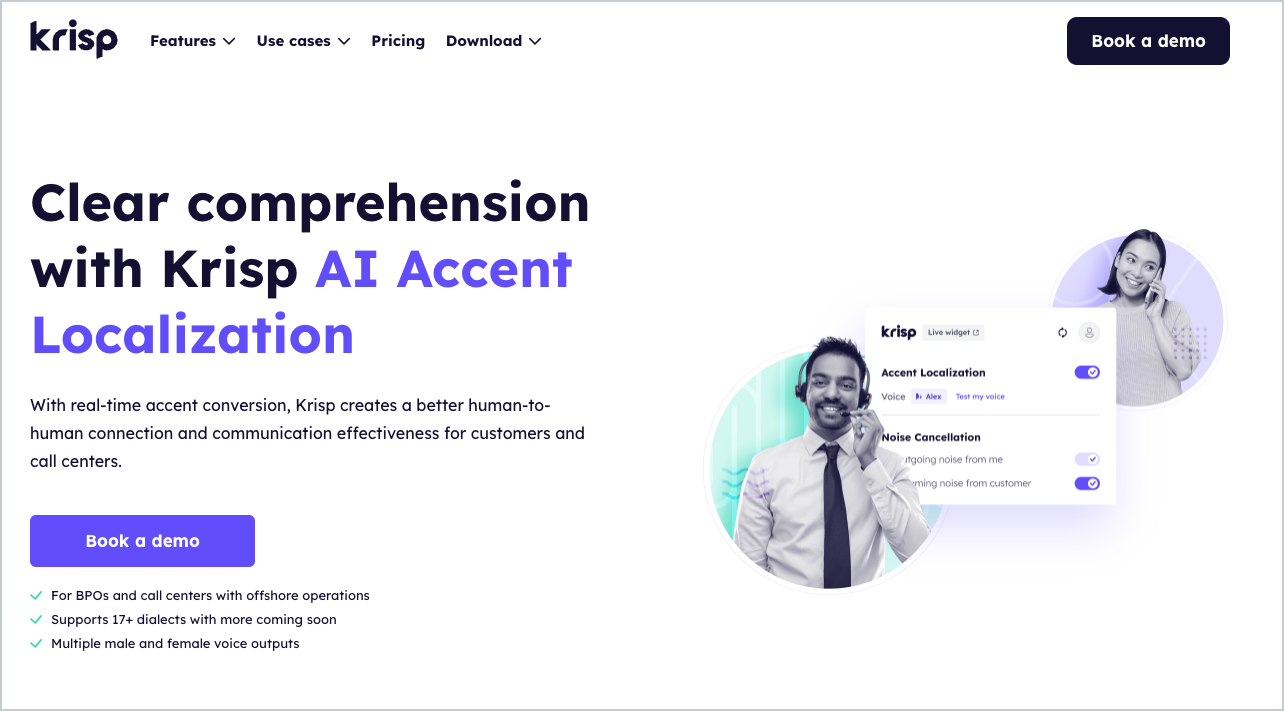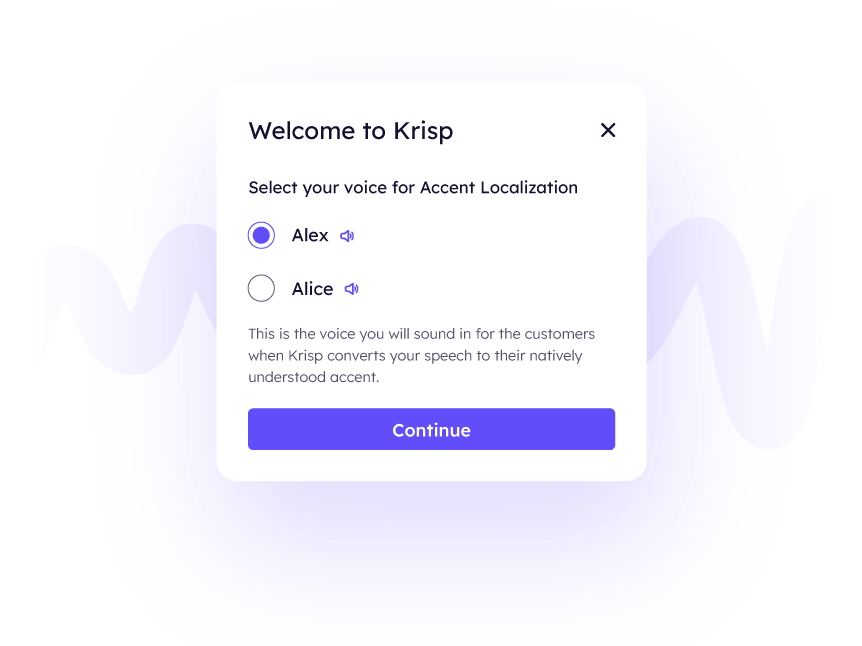Customer service is all about quick and clear conversations. Call centers connect businesses with customers, no matter where they are. But here’s the thing: with so many different accents out there, understanding each other can get tricky. That’s why call center accent training is super important. It’s a big topic that’s getting lots of attention and some pretty smart solutions nowadays.
What if staff training isn’t the only solution to navigating through different accents? Imagine a world where technology could effortlessly bridge the gap. This is where advanced software solutions come into play and we’ll discuss it in this article.
Accent Barriers at Call Centers
First off, let’s tackle the elephant in the room: accent barriers. Call centers, especially those serving international clients, encounter a wide variety of accents daily. This diversity, while enriching, can sometimes hinder clear communication. Misunderstandings arising from accent differences can lead to frustration on both ends of the line, potentially affecting customer satisfaction (CSAT) scores and, by extension, the reputation of the business.
Accent training in call centers aims to minimize these barriers, ensuring agents can communicate effectively with a global clientele. This training often involves accent neutralization—equipping agents with a more universally understandable accent—and accent comprehension, enhancing their ability to understand the diverse accents of callers.
Traditional vs Software Solution Accent Training Methods
| Aspect | Traditional Training | Software Solutions (Krisp) |
|---|---|---|
| Speed of Implementation | ❌ Slow: Requires setup and training periods. | ✅ Instant: Real-time accent modification. |
| Cost | ❌ Higher: Includes trainer, materials, and venue costs. | ✅ Lower: Primarily subscription or purchase cost. |
| Efficiency | ❌ Variable: Dependent on training quality and learning pace. | ✅ High: Consistent and immediate accent clarity. |
| Scalability | ❌ Limited: More resources needed for more agents. | ✅ Easy: Quickly scalable across any team size. |
| Cognitive Load on Agents | ❌ High: Constant focus on speech can detract from service. | ✅ Reduced: Agents focus more on service, less on speech. |
| Privacy and Security | ✅ Controlled internally. | ✅ Depends on the software’s data policies. |
| Customer Satisfaction Impact | ❌ Gradual: Improvements take time. | ✅ Immediate: Enhances clarity and comprehension quickly. |
Call Center Accent Training Traditional Methods
Accent training methodologies in call centers are as diverse as the accents themselves. They range from traditional in-person training sessions to innovative digital platforms that use speech recognition and artificial intelligence to tailor training to individual needs. These methods typically include:
| Method | Description |
|---|---|
| Phonetic Exercises | Focusing on the pronunciation of sounds that are often difficult for non-native speakers, such as the th sound in English. |
| Listening and Repetition | Utilizing audio recordings of native speakers to improve understanding and mimicry of target accents. |
| Role-playing | Simulating calls with diverse accents to provide real-world practice in a controlled environment. |
| Feedback and Coaching | Coaching agents and offering personalized feedback on their accent and comprehension skills, often through advanced software that can analyze speech patterns. |
Problems that Accent Conversion Solves at Call Centers
Accent neutralization, or accent reduction, aims to make an agent’s accent more understandable to a wide range of callers without erasing their linguistic identity. This approach addresses several key issues in call centers:
- Improved Customer Satisfaction: Clearer communication leads to more effective resolutions of customer queries, directly impacting CSAT scores.
- Reduced Miscommunication: By minimizing accent-related misunderstandings, call centers can operate more efficiently, with fewer calls needing escalation.
- Enhanced Global Reach: Agents with neutralized accents can communicate more effectively with a global audience, expanding the potential customer base for the business.

Krisp AI Accent Conversion: The Innovative Edge in Call Center Communication
Call center accent training has long been a staple of the industry, aiming to forge clear lines of communication across diverse customer bases. However, the evolution of AI technologies presents new avenues to streamline this process. Krisp AI Accent Conversion is at the forefront of this revolution, offering real-time accent conversion to enhance communication effectiveness.

Accent Conversion in Action with Krisp
Krisp’s accent conversion feature dynamically modifies an agent’s accent during a call. This ensures the customer hears the agent’s voice in an accent that is familiar and easily understandable, thereby reducing miscommunication and improving customer satisfaction. Below is a detailed table showcasing the key features of Krisp’s AI Accent Conversion:
| Feature | Description | Benefit for Call Centers |
|---|---|---|
| On-device Processing | Audio is processed on the device itself, ensuring real-time accent modification. | Enhanced privacy and lower latency. |
| Supports 17+ Dialects | Wide range of accents supported, with more being added regularly. | Greater reach to a diverse customer base. |
| Male and Female Voice Outputs | Offers a choice between male and female voice outputs for personalization. | Provides options for customer preference. |
| No Additional Integrations | Works with existing communication apps on Windows without extra setup. | Easy implementation with no additional costs. |
| Noise Cancellation | Along with accent modification, Krisp also provides noise cancellation features. | Clearer calls, free from background noise. |



Experience the magic of Krisp’s Accent Conversion
Why Choose AI Over Traditional Training?
While traditional training programs focus on long-term accent modification, AI-driven solutions like Krisp offer instant and dynamic adjustments. Here’s why this is a game-changer for call centers.
| Advantage | Description |
| ✅ Instant Implementation | Unlike conventional training that takes weeks or months, AI accent conversion works in real-time. |
| ✅ Reduced Training Time and Cost | AI eliminates the extensive hours and significant costs associated with ongoing accent training programs. |
| ✅ Cognitive Load Reduction | Agents can focus on customer service rather than the constant self-monitoring of their speech. |
| ✅ Scalability | Software like Krisp can be quickly rolled out across teams of any size, providing immediate benefits. |

Improving Agent Experience and Broadening the Hiring Pool
The use of AI for accent conversion isn’t just about customer experience; it’s also about enhancing the work life of call center agents. Krisp’s technology reduces the cognitive load on agents, who no longer need to focus on maintaining a neutral accent. This improves job satisfaction and retention rates.
Furthermore, the AI solution expands the hiring pool. Call centers can focus on hiring based on skill and fit rather than accent proficiency. This not only supports diversity and inclusion initiatives but also taps into a broader talent pool.
Conclusion: The Role of AI in the Future of Call Centers
In wrapping up, it’s clear that the landscape of call center operations is on the cusp of a significant evolution. As AI-driven technologies, such as advanced accent neutralization software, take the lead, they herald a departure from the age-old reliance on intensive accent training.
This transition is not just about adopting new tools; it’s a transformative shift towards harnessing technology to ensure every customer interaction is marked by clarity and understanding. In essence, we’re stepping into a future where global communication barriers are effortlessly navigated, thanks to the innovative solutions brought forth by AI.
FAQ on Call Center Accent Training

